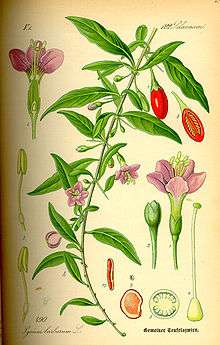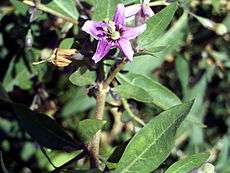Lycium barbarum
Lycium barbarum is a shrub native to China,[2][3][4] with present-day range across Asia and southeast Europe.[5] It is one of two species of boxthorn in the family Solanaceae from which the goji berry or wolfberry is harvested, the other being Lycium chinense.
| Lycium barbarum | |
|---|---|
| Lycium barbarum with ripe berries | |
| Scientific classification | |
| Kingdom: | Plantae |
| Clade: | Tracheophytes |
| Clade: | Angiosperms |
| Clade: | Eudicots |
| Clade: | Asterids |
| Order: | Solanales |
| Family: | Solanaceae |
| Genus: | Lycium |
| Species: | L. barbarum |
| Binomial name | |
| Lycium barbarum | |
| Synonyms[1] | |
| |
Common names of the plant in English include Chinese wolfberry,[2] Chinese boxthorn,[2] Himalayan goji,[2] Tibetan goji,[2] mede berry, barbary matrimony vine,[2] red medlar[6] or matrimony vine.[2] In the United Kingdom it is also known as Duke of Argyll's tea tree[2] or Duke of Argyll's tea plant,[2] after Archibald Campbell, 3rd Duke of Argyll who introduced it in the country in the 1730s.[2] The plant is called Murali in India,[7] and dretsherma (འདྲི་ཚིར་མ།, "ghost thorn") in Tibetan.
The shrub is an important commercial crop in northern China, especially in the Ningxia Hui Autonomous Region. Its Chinese name is Ningxia gǒuqǐ (宁夏枸杞 | 寧夏枸杞). It is also grown in Tibet, Mongolia, and more recently in many other countries of the world.
Description

Lycium barbarum is a deciduous woody shrub, growing 1–3 metres (3 ft 3 in–9 ft 10 in) high. The shrub has weak arching branches, and the side branches are often reduced to short leafless spines.[3]
Leaves and flowers

L. barbarum leaves form on the shoot either in an alternating arrangement, or in bundles of up to three. Each leaf is green, scarcely fleshy when fresh, usually lanceolate (spearhead-shaped), sometimes with rounded tips.[4] Clustered leaves are up to 25 mm long; the single alternate leaves are up to 55 mm long.[3]
The flowers grow in groups of one to three in the leaf axils, with pedicels 6–15 mm long. The calyx, eventually ruptured by the growing berry, is a whitish tube crowned by five or six radial triangular sepals, shorter than the tube, 10–12 mm long and 3–4 mm wide, sometimes 2–lipped, strongly curved. The sepals are whitish on the lower side (facing towards the branch) and deep mauve on the top side. Each flower has five stamens, exserted for 3–8 mm, with stalks longer than the anthers.[3] The pistil is 8–11.5 mm long. The anthers are longitudinally dehiscent.
Fruit
The fruit of L. barbarum, the main variety of goji berry, is a bright orange-red, ellipsoid berry 1–2 cm (0.39–0.79 in) in diameter. The fruiting calyx is split deeply once or twice. The number of seeds in each berry varies widely based on cultivar and fruit size, ranging from 10 to 60. The seeds are about 2 mm long, 1 mm wide, yellowish, compressed with a curved embryo.
Reproduction
The plants are self-pollinating, but may be cross pollinated by insects. The species is dispersed into natural areas by birds and other animals that eat its fruit.[8]
In the Northern Hemisphere, flowering occurs from June through September and berry maturation from August to October, depending on the latitude, altitude, and climate. Where frost does not occur fruiting is continuous and plants do not lose their leaves.
Occurrence and cultivation
China
Lycium barbarum has been cultivated in China, along the fertile aggradational floodplains of the Yellow River, for more than 600 years. It is still extensively cultivated in the Ningxia Hui Autonomous Region of north-central China, centered in Zhongning County, totaling 200,000 acres as of 2005,[9] The region produced 13,000 tons of fruit in 2001, accounting for 42% of the nation's total production of goji berries. The plant is also cultivated in the Xinjiang Uyghur Autonomous Region of western China,
The berries of L. barbarum are the only therapeutic grade ("superior-grade") kinds of wolfberries used by practitioners of traditional Chinese medicine.[10]
As Ningxia's borders merge with three deserts, L. barbarum is also planted to control erosion and reclaim irrigable soils from desertification.[11]
United Kingdom
Lycium barbarum has been used since the 18th century in the United Kingdom for hedging, especially in coastal districts. Its red berries are attractive to a wide variety of British birds.[12]
The plant continues to grow wild in UK hedgerows. On 15 January 2003, the Department for Environment, Food and Rural Affairs launched a project to improve the regulations protecting traditional countryside hedgerows, and specifically mentioned Duke of Argyll's Tea Tree as one of the species to be found growing in hedges located in Suffolk Sandlings, Hadleigh, Bawdsey, near Ipswich, and Walberswick.[13]
Importation of mature Licium barbarum plants into the United Kingdom from most countries outside Europe is illegal, due to the possibility they could be vectors of diseases attacking Solanaceae crops, such as potato or tomato.[14]
United States
Lycium barbarum has become a high demand plant in the United States. Nearly all major nursery catalogs now carry plants and there are many suppliers found on various web sites. There are a number of varieties available, ranging from leaf producing plants to fruit producing varieties. Most listed plants are hardy zones 5-9. One variety, Phoenix Tears is hardy zones 3-10. This variety produces fruit year round in warmer climates. Berries and leaves produced in the United States are probably more pesticide free than those produced in China.
At present only the US state of Pennsylvania requires inspection of imported L. barbarum plants. There have been cases of goji mite outbreaks in Pennsylvania and California. The mites have been found on wild plants in Utah and do have the potential to infect other family Solanaceae plants, but there is no documentation of such infections occurring in the United States.[15]
Australia
Lycium barbarum introduced to Australia became naturalised in south-eastern coastal and sub-coastal regions, and is regarded as an environmental weed in the provinces of Victoria and Tasmania. It is often found growing in disturbed sites, native bushland, and riverbanks, often forming dense thickets along the latter. It overlaps and is often confused with Lycium ferocissimum, a similar species originating from Africa.[8]
Chemistry
Because of its claimed benefits as a drug of traditional medicine, the chemicals present in the fruit, root, and other parts of the plants have been studied in some detail.[16][17]
The main compounds in the fruit (23% of the dry mass) are polysaccharides and proteoglycans. Carotenoid pigments are the second major group, chiefly zeaxanthin dipalmitate. The fruits further contain vitamins, in particular riboflavin, thiamin and ascorbic acid (vitamin C), the latter in a concentration similar to that in lemons. Other detected compounds include flavonoids derived from myricetin, quercetin, and kaempferol; hexadecanoic acid, linoleic acid, β-elemene, myristic acid and ethyl hexadecanoate; and some glycerogalactolipids. The fruit further contains 1–2.7% of free aminoacids; chiefly proline, and including gamma-aminobutyric acid (GABA) and betaine. Other compounds include β-sitosterol, scopoletin, p-coumaric acid, lyciumide A and L-monomenthyl succinate. The alkaloid atropine, common in plants of the family Solanaceae, is not detectable.[16]
The compounds present in the roots have been less studied, but they include betaine, choline, linoleic acid, and β-sitosterol [79]. Of particular interest are cyclic oligopeptides with 8 aminoacid rings, christened lyciumins A and B.[16]
The leaves are known to contain the flavonoids quercetin 3-O-rutinoside-7-O-glucoside, kaempferol 3-O-rutinoside-7-O-glucoside, rutin, nicotiflorin, isoquercitrin, quercetin, kaempferol damascenone, choline, scopoletin, vanillic acid, salicylic acid, and nicotinic acid. From the flowers, diosgenin, β-sitosterol, and lanosterol have been isolated.[16]
See also
- Goji
- Gouqi jiu
- List of culinary fruits
- List of dried foods
- Sea buckthorn – another medicinal plant that somewhat resembles wolfberry
References
- "The Plant List".
- "Lycium barbarum". Germplasm Resources Information Network (GRIN). Agricultural Research Service (ARS), United States Department of Agriculture (USDA). Retrieved 22 December 2017.
- Government of South Australia (2007), "Lycium barbarum". Online fact sheet on Electronic Flora of South Australia (eFloraSA). Accessed on 2018-05-04.
- T. Muer (2000), "Lycium Barabarum". Image on the Floraweb website, from "Bildatlas der Farn- und Blütenpflanzen Deutschlands" by H. Haeupler and T. Muer, 2000. Accessed on 2018-05-04.
- Flint, Harrison Leigh (1997). "Lycium barbarum". Landscape plants for eastern North America: exclusive of Florida and the immediate Gulf Coast. Chichester: John Wiley & Sons. p. 326. ISBN 978-0-471-59919-7.
- McAdam, Diana (12 October 2007). "Goji berries: The new superfruit". The Telegraph, Telegraph Media Group Limited, London, UK.
- Environment and Plant Life in Indian Desert, David N. Sen, Geobios International, 1982
- Queensland Government (2016), "Lycium barbarum". Online fact sheet on Weeds of Australia website. Accessed on 2018-05-04.
- Xinhua News Agency, Opening ceremonies of Ningxia wolfberry festival, August 3, 2005.
- Staff reporter, China's first provincial-level wolfberry association established, People's Daily Online, August 19, 2001.
- Archived 2015-09-23 at the Wayback Machine Yunyun L. Dry no more. BeijingReview.com.cn, October 11, 2008.
- A Touch Of Argyll In Norfolk Archived 2009-01-08 at the Wayback Machine Julia Page in The Corncrake, Colonsay, Scotland " I was intrigued to discover that the common name of lycium halimifolium is the Duke of Argyll's Tea-tree or Teaplant and was keen to discover how this name came about. I succeeded with the help of my friend Craig ( nice Scottish name ) at Kew Gardens Library and a historical Who's Who. Accessed November 2006
- Government Launches Consultation On Future Of Legal Protection For Hedgerows Archived 2009-07-20 at the Wayback Machine Department for Environment, Food and Rural Affairs, 15 January 2003. Retrieved 6 September 2006.
- Department for Environment, Food and Rural Affairs, April, 2008. Prohibited Import of Goji Plants Archived 2008-06-03 at the Wayback Machine. April 30, 2008
- Pennsylvania Dept. of Agriculture
- Olivier Potterat (2010): "Goji (Lycium barbarum and L. chinense): Phytochemistry, pharmacology and safety in the perspective of traditional uses and recent popularity". Planta medica, volume 76, issue 1, pages 7-19. doi:10.1055/s-0029-1186218
- Loraine Bonturi (2015), "Attività farmacologiche e possibili bersagli molecolari dei polisaccaridi del Lycium barbarum (LBP)" Graduation Thesis, Pharmacy Department, University of Pisa. Accessed on 2018-06-12.
External links
| Look up wolfberry or 枸杞子 in Wiktionary, the free dictionary. |
| Wikimedia Commons has media related to Lycium barbarum. |
- Flora of China citation for L. barbarum
- United States Department of Agriculture
- Plants For A Future database
- Montana plant life.org
- Lycium Fruit: Food and Medicine (2007) (Subhuti Dharmananda, Institute for Traditional Medicine)